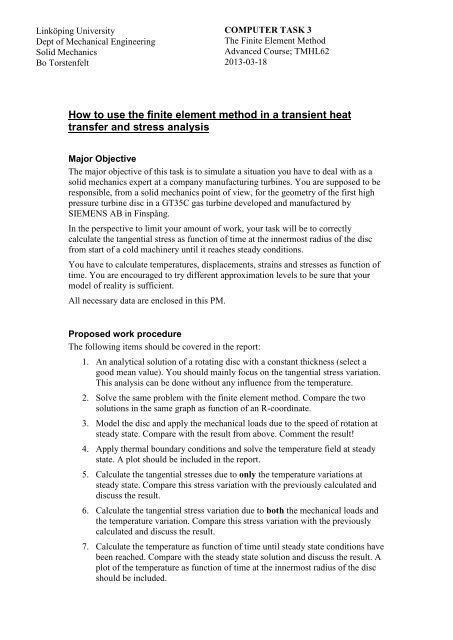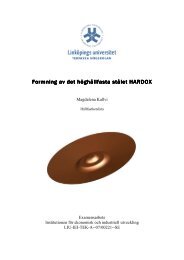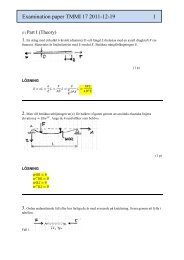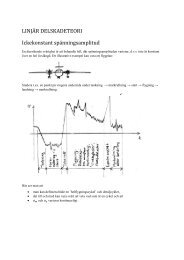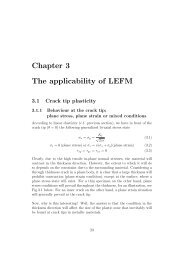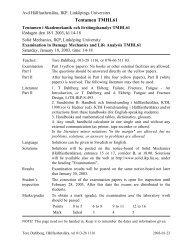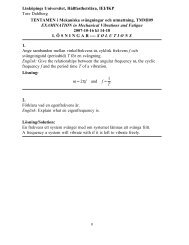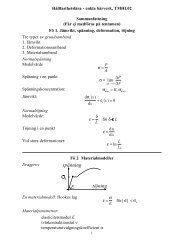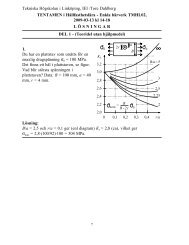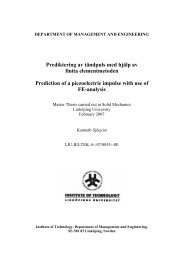Computer Exercise 3 - Division of Solid Mechanics - Linköping ...
Computer Exercise 3 - Division of Solid Mechanics - Linköping ...
Computer Exercise 3 - Division of Solid Mechanics - Linköping ...
You also want an ePaper? Increase the reach of your titles
YUMPU automatically turns print PDFs into web optimized ePapers that Google loves.
Linköping University<br />
Dept <strong>of</strong> Mechanical Engineering<br />
<strong>Solid</strong> <strong>Mechanics</strong><br />
Bo Torstenfelt<br />
COMPUTER TASK 3<br />
The Finite Element Method<br />
Advanced Course; TMHL62<br />
2013-03-18<br />
How to use the finite element method in a transient heat<br />
transfer and stress analysis<br />
Major Objective<br />
The major objective <strong>of</strong> this task is to simulate a situation you have to deal with as a<br />
solid mechanics expert at a company manufacturing turbines. You are supposed to be<br />
responsible, from a solid mechanics point <strong>of</strong> view, for the geometry <strong>of</strong> the first high<br />
pressure turbine disc in a GT35C gas turbine developed and manufactured by<br />
SIEMENS AB in Finspång.<br />
In the perspective to limit your amount <strong>of</strong> work, your task will be to correctly<br />
calculate the tangential stress as function <strong>of</strong> time at the innermost radius <strong>of</strong> the disc<br />
from start <strong>of</strong> a cold machinery until it reaches steady conditions.<br />
You have to calculate temperatures, displacements, strains and stresses as function <strong>of</strong><br />
time. You are encouraged to try different approximation levels to be sure that your<br />
model <strong>of</strong> reality is sufficient.<br />
All necessary data are enclosed in this PM.<br />
Proposed work procedure<br />
The following items should be covered in the report:<br />
1. An analytical solution <strong>of</strong> a rotating disc with a constant thickness (select a<br />
good mean value). You should mainly focus on the tangential stress variation.<br />
This analysis can be done without any influence from the temperature.<br />
2. Solve the same problem with the finite element method. Compare the two<br />
solutions in the same graph as function <strong>of</strong> an R-coordinate.<br />
3. Model the disc and apply the mechanical loads due to the speed <strong>of</strong> rotation at<br />
steady state. Compare with the result from above. Comment the result!<br />
4. Apply thermal boundary conditions and solve the temperature field at steady<br />
state. A plot should be included in the report.<br />
5. Calculate the tangential stresses due to only the temperature variations at<br />
steady state. Compare this stress variation with the previously calculated and<br />
discuss the result.<br />
6. Calculate the tangential stress variation due to both the mechanical loads and<br />
the temperature variation. Compare this stress variation with the previously<br />
calculated and discuss the result.<br />
7. Calculate the temperature as function <strong>of</strong> time until steady state conditions have<br />
been reached. Compare with the steady state solution and discuss the result. A<br />
plot <strong>of</strong> the temperature as function <strong>of</strong> time at the innermost radius <strong>of</strong> the disc<br />
should be included.
Linköping University<br />
Dept <strong>of</strong> Mechanical Engineering<br />
<strong>Solid</strong> <strong>Mechanics</strong><br />
Bo Torstenfelt<br />
COMPUTER TASK 3<br />
The Finite Element Method<br />
Advanced Course; TMHL62<br />
2013-03-18<br />
8. Calculate the tangential stress as function <strong>of</strong> time due to both the mechanical<br />
loads and the temperature variation. You have to select the positions in time<br />
carefully. Hint: They must not be equally space in time over the entire time<br />
domain. A plot <strong>of</strong> the tangential stress as function <strong>of</strong> time at the innermost<br />
radius <strong>of</strong> the disc should be included.<br />
9. A final discussion including reason for why your analysis is so accurate with<br />
respect to modelled geometry, choice <strong>of</strong> number and type <strong>of</strong> elements and<br />
application <strong>of</strong> mechanical and thermal boundary conditions.
Linköping University<br />
Dept <strong>of</strong> Mechanical Engineering<br />
<strong>Solid</strong> <strong>Mechanics</strong><br />
Bo Torstenfelt<br />
COMPUTER TASK 3<br />
The Finite Element Method<br />
Advanced Course; TMHL62<br />
2013-03-18
Linköping University<br />
Dept <strong>of</strong> Mechanical Engineering<br />
<strong>Solid</strong> <strong>Mechanics</strong><br />
Bo Torstenfelt<br />
COMPUTER TASK 3<br />
The Finite Element Method<br />
Advanced Course; TMHL62<br />
2013-03-18
Linköping University<br />
Dept <strong>of</strong> Mechanical Engineering<br />
<strong>Solid</strong> <strong>Mechanics</strong><br />
Bo Torstenfelt<br />
COMPUTER TASK 3<br />
The Finite Element Method<br />
Advanced Course; TMHL62<br />
2013-03-18
Linköping University<br />
Dept <strong>of</strong> Mechanical Engineering<br />
<strong>Solid</strong> <strong>Mechanics</strong><br />
Bo Torstenfelt<br />
COMPUTER TASK 3<br />
The Finite Element Method<br />
Advanced Course; TMHL62<br />
2013-03-18
Linköping University<br />
Dept <strong>of</strong> Mechanical Engineering<br />
<strong>Solid</strong> <strong>Mechanics</strong><br />
Bo Torstenfelt<br />
COMPUTER TASK 3<br />
The Finite Element Method<br />
Advanced Course; TMHL62<br />
2013-03-18
Linköping University<br />
Dept <strong>of</strong> Mechanical Engineering<br />
<strong>Solid</strong> <strong>Mechanics</strong><br />
Bo Torstenfelt<br />
COMPUTER TASK 3<br />
The Finite Element Method<br />
Advanced Course; TMHL62<br />
2013-03-18


